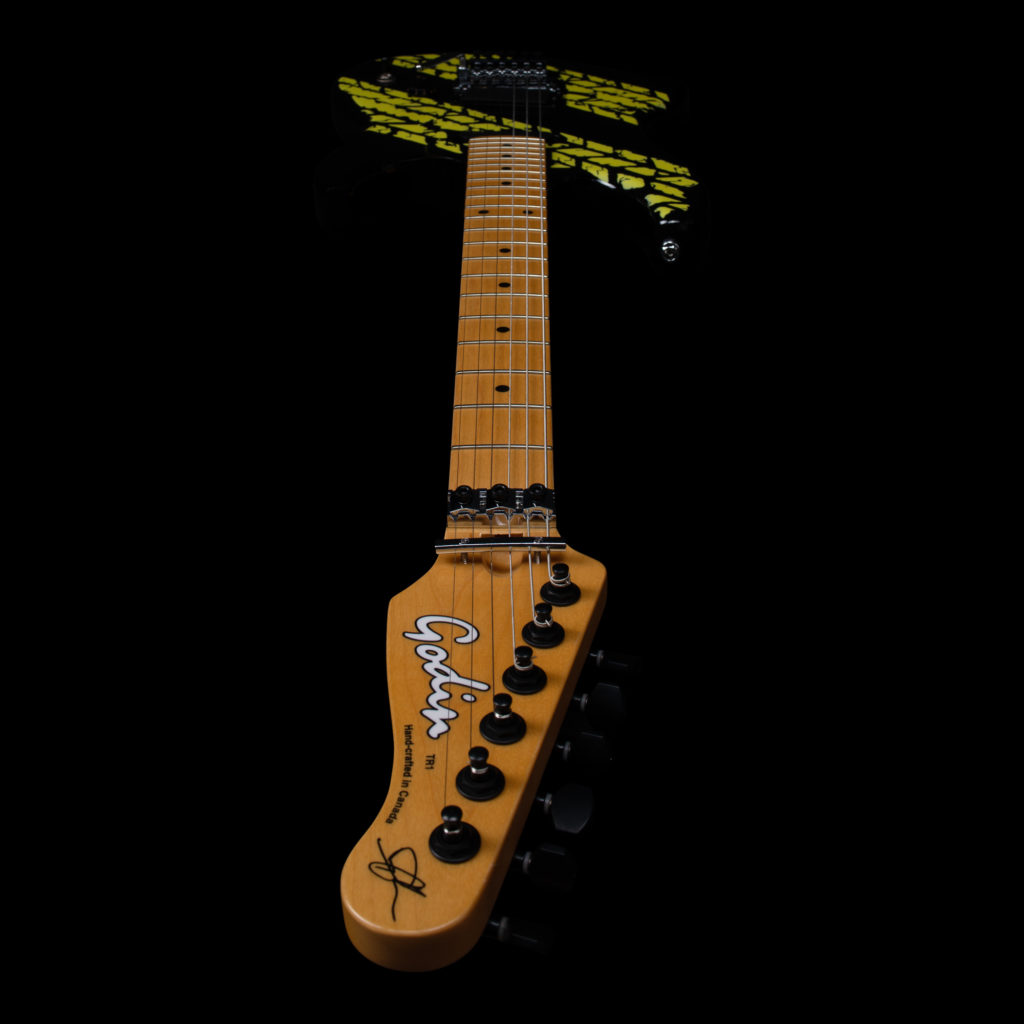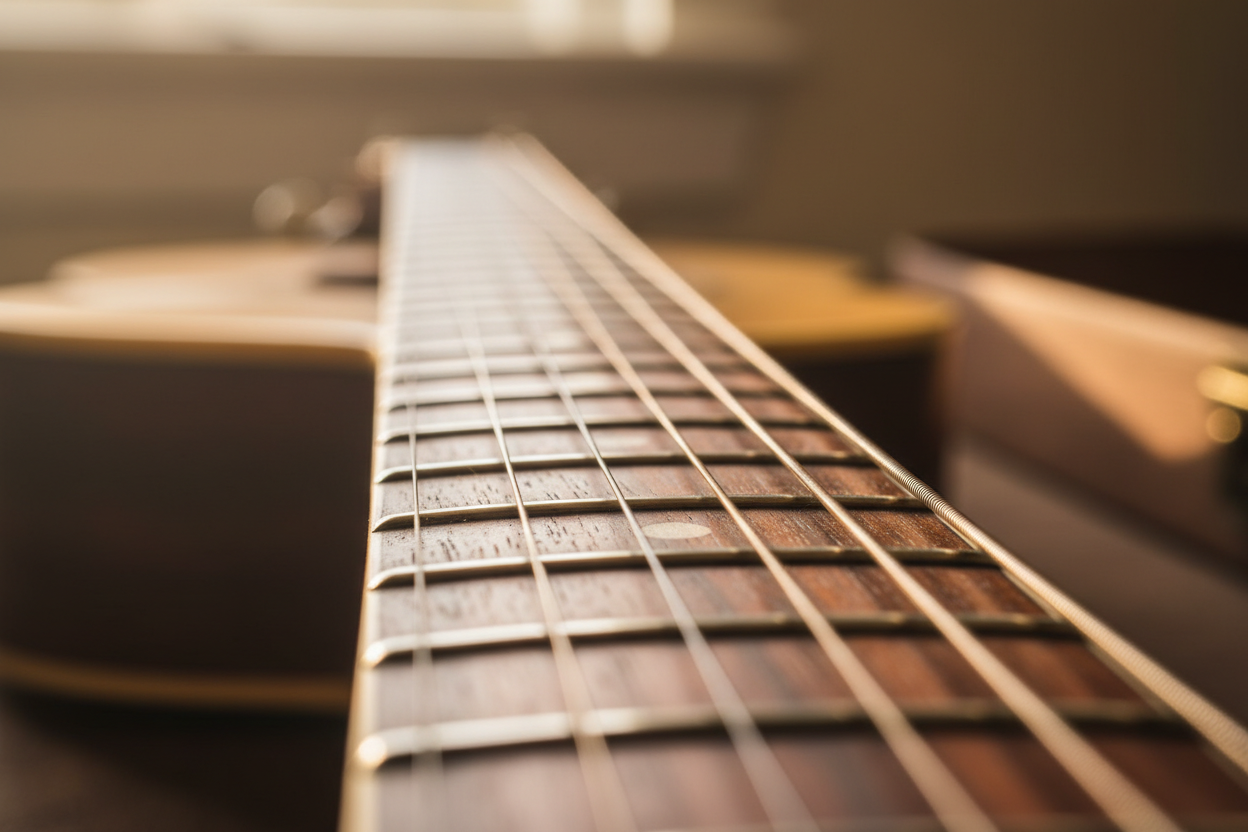Necks affect the sound of a guitar by a minimal amount, usually unnoticeable except by experts and enthusiasts. Guitar neck shapes vary to accommodate different play styles and other specifics of a guitar, such as neck length, scale length, and other features you’ll find in this article. While some are more popular, there are several specific neck shapes developed for highly particular play styles as well.
Let’s delve into guitar neck shapes a little deeper so you can get the picture of what you could look for when choosing your first (or next) guitar.
Neck Shapes 101
When examining guitar necks, there are some particular specifications included in the neck that defines its shape. Here, we will discuss the basics and the standard terms we use when examining and considering a neck shape.
Let’s break it down – we take off the strings, the body, and the headstock, so we are only left in the neck. When we examine the neck itself, we see two distinct areas – the fretboard and the body of the neck – this is the neck itself.
What is NOT related to the guitar neck shape?
Let’s make a difference between the fretboard shape and the shape of the neck itself. The fretboard with its frets can also vary by shape and material. There are differences between popular rosewood fretboards and exotic ebony fretboards, The types of frets, fret layout, and fretboard shape is a topic of its own.
We won’t focus on the fretboard as much in this article. However, an important thing to consider when picking the guitar is how much your fretboard is curved, so we will cover the topic of fretboard radius and why this is important too.
What do we talk about exactly when we talk about neck shapes?
The guitar neck doesn’t only carry the guitar’s soul or truss rod; it also has its function in how it is shaped.
To look at the neck’s shape, we can have two approaches. The first is to look at it by cross-section – this is how we can distinguish between the different shapes. Since we don’t want to cut a perfectly good guitar neck in half, we can also examine it externally, and we can let our hands “see” it as well as the eyes. Different neck shapes are made to help the hands adjust to it better for playing.
Examining the neck, we are interested in the way it curves perpendicular to its length, and the thickness it has relative to the fretboard and our hands. You already may have noticed that guitars have thinner necks than bass guitars, for example. This is not only due to the constitution of a bass guitar that has to handle more strain force for the strings – for many players, but it’s also easier to play the bass guitar with thicker necks.
These thickness and curve nuances carry over to different playstyles on a guitar, as well as the hand and finger constitution of a guitar player.
What Guitar Neck Shapes Are There? How many?
To make things easier and if we exclude some highly exotic custom guitar shapes that a single person in the world uses, we can make a difference between 8 guitar neck types. Among them, some are way more common than others, and we will put more emphasis on them.
The neck shapes you can easily find are the two varieties of V shape, D, U, and the classic C shape. These names shapes are given to the shapes that most resemble the letter they’re named after.
There are also three less commonly used types with their own advantages and disadvantages – the Chunky C shape, the BB Bat shape, and the Asymmetrical. Let’s go through every one of them and explain them in more detail.
The List of Guitar Neck Shapes
Here, we will break down the list of guitar shapes and figure out their pros and cons.
C Guitar Neck Shape (Classic)

If you asked yourself, “What guitar neck is easiest?” and haven’t found an answer, it is because every player has to decide this for themselves. However, Fender, as one of the best guitar makers in the business, decided on the C neck shape for their guitars and introduced some variety of the shape over the years.
This is generally the most commonly seen neck shape across all markets, becoming popular in the late 70s and early 80s. The oval curvature ensures optimal comfort for most players and play styles. Classic C shapes are usually on the thin side of guitar necks, which can be seen on Fender guitars which are generally thinner than the average C-shaped necks.
When you look at what shape Strats have and the shapes that Gibson guitars have, you will see a C shape most commonly.
Pros
Optimal comfort for most players
Even curvature throughout
Optimal for holding chords and playing solos and licks
Cons
Not great for long fingers and large hands
Not as ergonomic as some other neck shapes
C Shape (Chunky)

The oval curvature can allow for resting the palm of your hands while playing and adjusting it easily as you go across strings of your fretboard. It can also come with wider fretboards, allowing for more spacing between the strings.
The taper is minimal or non-existent with C shape necks. This encourages palm rests and gives consistency for palm adjustments across the neck. This arguably can provide more strength to fingers when pressing the strings, which is great for rhythm guitar parts and endurance. However, the same feature makes it less comfortable and clunky when supporting the hand with the thumb, offering less maneuver, nuance, and playtime.
Pros
For endurance playing
Finger power when palm resting
Consistent support adjustment across the neck
Cons
More tiring when thumb resting (in general)
Less speed and maneuver
Limited reach (the hand is more static)
U Shape Necks

U shapes were the original rhythm guitar neck shapes. U shapes are referred to what is considered a fat guitar neck. They provide thick necks with steady hand rests, suitable for holding chords for a long while strumming. In addition, it developed its own bar chord techniques and allowed for playing longer without tiring the hands and finger cramps.
Being more rounded than Chunky Cs, they offered more stability while playing and allowed players easier adjustment to static hand positioning. It was also favored by players with larger hands, compensating for the gap and hand clenching on thinner necks, which is known for reducing speed and precision in finger work.
Pros
Great for players with large hands
Endurance playing
Easy positioning
Comfortable static hand positioning
Cons
Too thick for smaller hands
Reduces speed for some lick techniques
BB Bat Shape

BB Bats, or Baseball Bats, are even thicker and chunkier guitar necks that are not as commonly seen nowadays. They are built for large hands and are an echo of the old times when guitars were generally made with chunkier necks. They can rest well in large hands and provide a little more leverage for finger pressing. Some players could utilize thumb-pressing the lower E strings to get some chords commonly used in Jazz.
Pros
Large hands only
Good for thumb-playing techniques
Comfortable static grip
Cons
Very difficult for small hands
Heavy necks
Not easy to find
Soft V Shape

Soft Vs have a steeper line meeting the fretboard and a more pronounced curve on the center. Invented by accident, it was developed by Fender when finding that it could bring more comfort to those that hover and rest the thumb on the neck more.
The setup can bring more maneuverability to thumb-resting play styles, which are commonly related to arpeggios and solos.
Pros
Thin neck, suitable for smaller hands
More reach since the player is enforced to rest their thumb
Enhances faster playing
Cons
Alters chord techniques
It doesn’t incentivize bar playstyle
Hard V Shape

Hard Vs are very rare and almost limited to reissue models. It had an even steeper center favored by some players for specific palm resting and switching to thumb resting quickly. Licks and solos were incentivized, though it was not the “go-to” neck for most players.
Pros
Incentivizing fast playing and licks
Comfortable thumb rest
Cons
Hard to find
Incentivizes neck-specific techniques
D Shape Neck

Ds is also called Modern Cs. They are very thin necks for highly specific, “fast” playstyles. Another positive thing is that, due to their thickness or the lack of it, they are great for smaller hands.
Thumb rest is almost exclusively used with D shapes. The slightly less curved neck than the C gives a little more edge on hand repositioning for more nimble crossings across the neck as well as the strings. However, if you wondered, “can a guitar neck be too thin?” – the answer is yes if you are looking to develop various play styles, not only solos and fast shredding.
Pros
Great for shredding
Delicate thumb rest gives nimbler fingers
Easy sweeping across strings and neck
Cons
Much less comfort for larger hands
Can create hand cramps when playing static
Asymmetrical Guitar Necks

Asymmetrical necks come in different forms, often customized for specific players. They don’t peak at the center of the neck but are slightly lower. This gives less curvature from the top and a steeper drop on the bottom. This is to adjust more ergonomically to the fingers and palm/thumb resting, offering more precision while playing.
Asymmetrical accommodates skillful players that want to achieve nuances in performance for their specific play styles. They are arguably the most interesting yet the least common by model. Some of the models you can check out are Suhr Modern, Les Paul Standards, Music Man Axis Super Sport, and don’t forget to check out EndurNeck by Strandberg.
Pros
Ergonomic perfection
Maximizes speed and precision
Cons
Highly individual
Rare and expensive
Fretboard radius
Along with the neck shape, you will also find differences in how much a fretboard is curved. There are differences in fretboard curvature, and as slight, as they may appear, you may feel the difference. Some players prefer a slightly curved fretboard for better finger adjustment, while others would appreciate a flatter one.
Given that fretboards are commonly curved evenly, they can be treated as part of a larger circle. If you took the curvature as a starter to draw a circle, you would get one with a specific radius.
For example, a 16” fretboard would form a circle with a 16” radius. The larger the number, the less curve a fretboard has.
This variable can affect how wide your fretboard is or how your strings are spaced. You can find that you’ll make fewer mistakes hitting strings on a more curved fretboard and vice versa. To test this, you can consider trying a classical guitar, which has a flat fretboard, and then a guitar you had your eyes on.
What is the Best Guitar Neck Shape?
Browsing through the different guitar necks listed, you can easily conclude that you would probably have to go a long way to find the perfect guitar neck shape. However, since this won’t be the case for most of us mortals, the best course of action is to try out as many as you can on several play sessions if possible.
This will build experience for how your hands adjust and handle different guitar neck shapes. You will notice whether it allows and helps your play style or it feels off in a sense. The general rule of thumb is to go for thicker guitar necks if you have large hands and avoid them if they feel too much to handle. However, large-hand players can find that they can handle thinner necks on occasions, depending on how they approach the instrument.
It’s important to take this information with curiosity rather than feeling it’s intimidating. Any guitar is better than no guitar when it comes to practicing and skill, and as you practice on a guitar that’s available, you will get a better picture for the next one. However, it’s good to have this all in mind if you are already picking a guitar.




